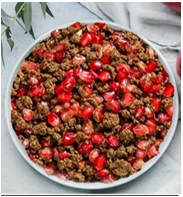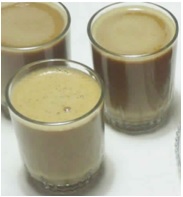ENTER A PRODUCT: Submission #39
Secondary tabs
Submission information
Submission Number: 39
Submission ID: 45
Submission UUID: 3075e097-722d-4e68-b80a-010a887692d3
Submission URI: /slowfood/form/segnala-un-prodotto-bk1
Created: Wed, 03/22/2023 - 13:11
Completed: Wed, 03/22/2023 - 13:14
Changed: Tue, 09/19/2023 - 12:59
Remote IP address: (unknown)
Submitted by: admin-form
Language: English
Is draft: No
Current page: Complete
Webform: ENTER A PRODUCT
| Product name | Zammit makhdhour | ||
|---|---|---|---|
| Category |
|
||
| Geographic area | Geographic area: Sfax, Tunisia Latitude: 34.739822 Longitude: 10.7600196 Location: 34.739822,10.76002 Formatted Address: Sfax, Tunisia Locality: Sfax State/Province: Governatorato di Sfax Country: Tunisia Country Code: TN |
||
| Product description | Zammit makhdhour is made with barley seeds flour. In Sfax, the main barley variety is beldi variety, that can be translated as "local barley", passed down from father to son. There is specialized mill called tahune, that sift previously chopped barley using modern electric bales. The beldi flour is widespread in the areas around the towns of Sfax and Sidi Bouzid, respectively in the east and in the centre of Tunisia. This variety represented the basic cereal of the inhabitants of Sfax. The future of the beldi barely is at risk, substituted by other varieties, more productive but also exigent in term of water and chemicals needed for the production. Beldi barely is often produced only for home consumption and it is rarely possible to find this type of cereal in farmers’ markets. |
||
| Gastronomic use | Zammit is a Berber food called “Tazmit”, made from wheat or barley flour. It is present on the breakfast table in the summer because of its coldness in the stomach, as it is said, “Al-Zammit is cold,”. It reduces excessive thirst. Al-Zammit can be made with mature barley seeds or with green barley seeds, in this case is called Zammit makhdour. The product is characterized by its yellow colour. Prepared from barley flour, Zammit contributes to good digestion thanks to its curative properties and nutritional contribution (trace elements, mineral salts, polyphenols, slow sugars, etc.). Zammit is eaten, generally, at breakfast. It is also very popular during the month of Ramadan, where its richness in calories and vitamins allow its consumers to better endure fasting during the day. Farmers generally keep it for their self-sufficiency, selling a small quantity on demand to people in Sfax. Green barley grains are rosted in the stove called tawa or tajen. Small amount of barley seeds (about a half a saa, that corrsepond toا 2.5 kg) are roasted in the firewood. Then, barley seeds are rubbed with the legs five times and after each time sifted to get rid of the residual, with no salt or spices added to it. It is crushed and sieved. Zammit can be mixed with olive oil (to have a paste) or with fresh water and honey to get a liquid called "dardoura". The paste could be eaten alone or with different fruits, like figs and grapevines in summer and pomegranate in autumn. |
||
| Relationship with the local ecosystem and processing | The plant is short but resistant to flooding and infestation. Flowering requires a minimum amount of water (100 to 200 mm of rainwater, compared to 300 to 400 for other varieties). Barley is sown at the foot of the tabia طابية (earthen dams used in Tunisia to collect rainwater and delimit the perimeters of fields) in October. A third of the production is harvested at the end of April, when seeds still have a green colour. The harvested barley is used to produce couscous (makdour) and zammit makdour. The rest of the harvest is done in May, to produce couscous and flour for the preparation of bread and soups. These products were prepared at home, using sunshine and breeze to drying them. | ||
| Culture and history | In ancient times, traces of Zammit can be found in Roman era, canvases, etc. El Wazen, reports in his description of "Ifriquia" ( افريقية ; current Tunisia), that the Berbers used to eat during the day a meal of barley mixed with olive oil (to have a paste) or with water, and this liquid was called "Zammit or dardoura" | ||
| IS IT PRODUCED BY AN INDIGENOUS PEOPLE / COMMUNITY? | NO | ||
| ADD IMAGE |
|
||
| SUMMARY | Zammit makhdhour is made with barley seeds flour. In ancient times, traces of Zammit can be found in Roman era, canvases, etc. El Wazen, reports in his description of "Ifriquia" ( افريقية ; current Tunisia), that the Berbers used to eat during the day a meal of barley mixed with olive oil (to have a paste) or with water, and this liquid was called "Zammit or dardoura". Zammit is a Berber food called “Tazmit”, made from wheat or barley flour. It is present on the breakfast table in the summer because of its coldness in the stomach, as it is said, “Al-Zammit is cold,”. It reduces excessive thirst. Al-Zammit can be made with mature barley seeds or with green barley seeds, in this case is called Zammit makhdour. The product is characterized by its yellow colour. In Sfax, the main barley variety is beldi variety, that can be translated as "local barley", passed down from father to son. Prepared from barley flour, Zammit contributes to good digestion thanks to its curative properties and nutritional contribution (trace elements, mineral salts, polyphenols, slow sugars, etc.). Zammit is eaten, generally, at breakfast. It is also very popular during the month of Ramadan, where its richness in calories and vitamins allow its consumers to better endure fasting during the day. Farmers generally keep it for their self-sufficiency, selling a small quantity on demand to people in Sfax. Green barley grains are rosted in the stove called tawa or tajen. Small amount of barley seeds (about a half a saa, that corrsepond toا 2.5 kg) are roasted in the firewood. Then, barley seeds are rubbed with the legs five times and after each time sifted to get rid of the residual, with no salt or spices added to it. It is crushed and sieved. Zammit can be mixed with olive oil (to have a paste) or with fresh water and honey to get a liquid called "dardoura". The paste could be eaten alone or with different fruits, like figs and grapevines in summer and pomegranate in autumn. |


